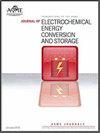锂离子电池组电池-电池组结构热性能的实验与模拟研究
IF 1.9
4区 工程技术
Q3 ELECTROCHEMISTRY
Journal of Electrochemical Energy Conversion and Storage
Pub Date : 2022-10-28
DOI:10.1115/1.4056112
引用次数: 0
摘要
提出了一种新的模拟电池温度从下表面到上表面变化的模型。通过实验标定,建立了单元模型。同时,通过实验对标建立了电池-电池组模型。此外,还比较了Cell-to-Pack和在此基础上有外壳的普通电池组在四种不同工况下的热性能。结果表明,在电池-电池组中增加外壳对电池组的热性能影响不大。在电池-电池组中增加一个外壳几乎不能改善电池在冷却条件下的温度均匀性;模块两端电池上下表面温差下降约0.5℃,中心温差基本不变。与无冷却快速充电相比,有冷却快速充电电池温度下降超过12℃。更重要的是,电池的比能量和封装效率分别从160.27Wh·kg - 1和73.1%下降到148.72 Wh·kg - 1和67.8%。本文章由计算机程序翻译,如有差异,请以英文原文为准。
Experimental and Simulations Study of Thermal Performance of Cell-to-Pack Structure for a Li-ion Battery Pack
A new model for simulating battery temperature changes from the lower surface to the upper surface is proposed. The cell model is established with experimental calibration. Simultaneously, the Cell-to-Pack model is established through experimental benchmarking. In addition, the thermal properties of Cell-to-Pack and an ordinary battery pack that has an enclosure on the basis were compared under four different working conditions. The results indicate that adding an enclosure to the Cell-to-Pack has little effect on the thermal performance of the battery pack. Adding an enclosure to the Cell-to-Pack hardly improve the temperature uniformity of the battery under cooling conditions; the temperature difference between the upper and lower surfaces of the batteries at both ends of the module drops by approximately 0.5°C, while the central temperature difference is basically unchanged. Compared with fast charging without cooling, the battery temperature dropped by more than 12°C under the fast charge condition with cooling. More importantly, the specific energy and packaging efficiency of the battery dropped from 160.27Wh·kg−1 and 73.1% to 148.72 Wh·kg−1 and 67.8%, respectively, after the Cell-to-Pack was added with an enclosure.
求助全文
通过发布文献求助,成功后即可免费获取论文全文。
去求助
来源期刊

Journal of Electrochemical Energy Conversion and Storage
Engineering-Mechanics of Materials
CiteScore
4.90
自引率
4.00%
发文量
69
期刊介绍:
The Journal of Electrochemical Energy Conversion and Storage focuses on processes, components, devices and systems that store and convert electrical and chemical energy. This journal publishes peer-reviewed archival scholarly articles, research papers, technical briefs, review articles, perspective articles, and special volumes. Specific areas of interest include electrochemical engineering, electrocatalysis, novel materials, analysis and design of components, devices, and systems, balance of plant, novel numerical and analytical simulations, advanced materials characterization, innovative material synthesis and manufacturing methods, thermal management, reliability, durability, and damage tolerance.
 求助内容:
求助内容: 应助结果提醒方式:
应助结果提醒方式:


